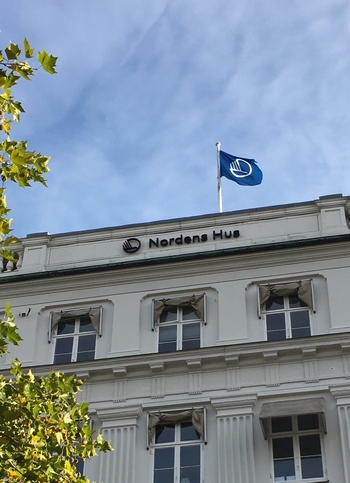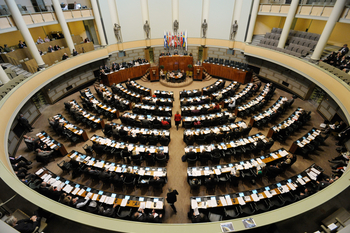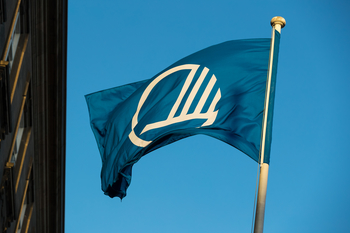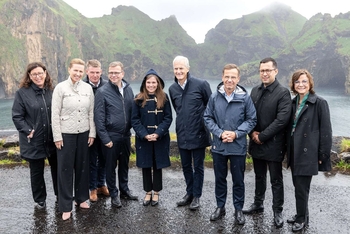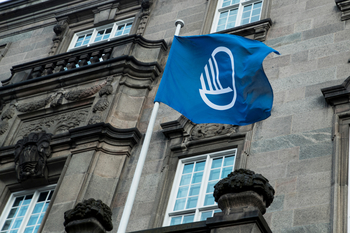The history of Nordic co-operation
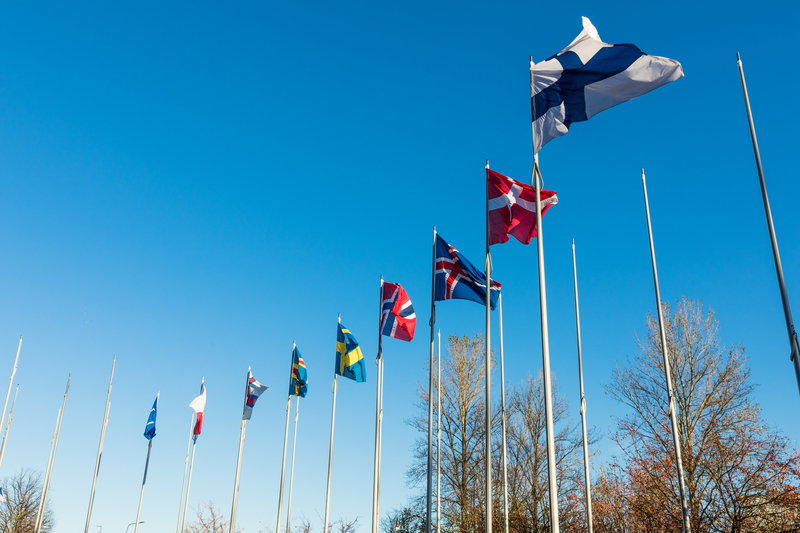
A thousand years ago, the Nordic peoples began to come together and form kingdoms. For centuries prior to this, the people of the North who traded with and plundered lands further afield had been known as Vikings.
As Christianity began to make inroads, the wild days of plunder and pillage came to an end. From time to time, however, wars still raged – including between the Nordic kingdoms.
From 1397 to 1521, the kingdoms were united under the Kalmar Union. Already the ruler of Norway and Denmark, Queen Margrete I was appointed regent of Sweden in 1389.
Her kinsman Erik of Pomerania was crowned king in Kalmar on 17 June 1397. The Kalmar Union lasted until 1521, when Gustav Vasa was crowned King of Sweden.
The Nordic countries remained divided for the next 300 years. The Swedish kingdom claimed Finland, and gradually absorbed several territories around the Baltic Sea.
The Danish kingdom included Norway, Iceland, Greenland and the Faroe Islands. The two kingdoms waged many wars against each other.
At first, the Danish Crown was the stronger, but Sweden gained the upper hand during the Thirty Years’ War (1618–1648).
However, following its defeat in the Great Northern War in the early 18th century, Sweden was no longer an imperial power. Instead, Russia and Prussia became the dominant states around the Baltic.
The Napoleonic Wars brought more change. Russia attacked and occupied Finland, taking it from the Swedes, and installed the Tsar as Grand Duke of Finland in 1809. Under the Treaty of Kiel, Denmark was forced to cede Norway to Sweden, creating a union that lasted from 1814 to 1905.
In 1875, Sweden, Denmark and Norway created a Scandinavian monetary union, which formally remained in place until 1924. In practice, however, it ended during World War One, when its currency, the Crown, no longer had the same value in the different countries in relation to gold.
In 1905, the union between Sweden and Norway was dissolved, and Norway declared independence. Finnish independence followed on 6 December 1917. A year later, Iceland achieved a significant degree of autonomy, but retained the Danish monarchy and was subject to Danish foreign policy until 1944.
Åland’s fate remained a source of conflict between Sweden and Finland until the League of Nations decreed that it should be part of Finland.
As early as the late 19th century, a large number of organisations started to initiate grassroots Nordic partnerships. To this day, it is this popular support that remains the bedrock that underpins formal co-operation.
The Nordic Association was founded in Denmark, Norway and Sweden in 1919, then in Iceland in 1922 and Finland in 1924. It has been a key factor in encouraging closer Nordic co-operation every since.
The “twin towns” are one visible result of this co-operation. In 1939, Thisted in Denmark established close ties with Uddevalla in Sweden, and many more have since followed their example.
Before World War Two, the Nordic Social Democrats and trade unions came together in the Joint Committee of the Nordic Social Democratic Labour Movement (SAMAK).
At SAMAK’s first meeting after the war, held in Stockholm in July 1945, the assembled top politicians agreed to pursue Nordic policies in a number of fields.
In May 1948, the Swedish Minister of Foreign Affairs, Östen Undén, proposed the creation of a Scandinavian defence union. However, negotiations broke down permanently in early 1949, when Norway and Sweden were unable to establish common ground.
Instead, Denmark, Iceland and Norway opted to join NATO, while Sweden insisted on remaining neutral.
In 1952, Denmark, Iceland, Norway and Sweden formed the Nordic Council. Finland, which at that point in time was still very much under the sway of its neighbour, Stalin’s USSR, did not join until 1955, when relations thawed under Khrushchev, the new Soviet leader.
The 1950s saw plans for both a Nordic free-trade area and a Nordic customs union. However, in 1960, Sweden, Norway and Denmark opted to join EFTA instead.
Finland became an associate member of EFTA in 1961, and Iceland joined in 1970. For a brief period, all of the Nordic countries were part of the same free-trade area.
However, the EEC was a closer and more binding body than EFTA. In July 1961, the United Kingdom applied to join the EEC, followed by Denmark and Norway.
All three applications stalled due to President de Gaulle’s opposition to British membership, and negotiations finally collapsed in January 1963.
These problems within the EEC made a permanent treaty on Nordic co-operation seem more attractive. Such a treaty was finally ratified in Helsinki on 23 March 1962 – which is why the Nordic “constitution” is known as the Helsinki Treaty.
Between 1968 and early 1970, intense negotiations took place on Nordic economic co-operation within a framework known as Nordek. However, the negotiations foundered when Finland stated it could not participate because of its relationship with the Soviet Union.
This setback led to a new initiative, and the Nordic Council was set up in 1971.
On 1 January 1973, Denmark was the only Nordic country that was a member of the EEC. The purpose of the Nordic Council of Ministers was to support and maintain co-operation between the countries.
Anker Jørgensen, the Danish Prime Minister at the time, wrote in a postscript to his published diaries that Denmark’s EEC membership had not caused it to neglect Nordic co-operation:
"On the contrary, we tried in a way – and in accordance with the wishes of the other Nordic countries – to build bridges between the Nordic Region and Europe."
In July and August 1975, Finland hosted the major OSCE conference on security and co-operation in Europe.
At first, its resolutions were mostly considered little more than fine words. However, the chapter on human rights, which formed the basis for the Helsinki Declaration, would help to sow “the seeds of freedom” in Eastern Europe.
The fall of the Berlin Wall on 9 November 1989 fundamentally changed the political map of Northern Europe.
At the end of 1989, democracy was introduced to Poland and the GDR, which then reunited with West Germany on 3 October 1990. The Soviet Union collapsed in 1991.
The Baltic countries, which had previously tried to assert greater autonomy, regained the full independence they had enjoyed between the two World Wars.
Even prior to independence, the Nordic countries had made contact with the Baltic nations to discuss setting up Nordic Council of Ministers information offices there.
In 1994, Finland, Norway and Sweden all held referenda on EU membership.
Finland and Sweden voted yes, and joined on 1 January 1995, along with Austria. Norway again voted no.
In October 1999, the five Nordic nations opened a joint embassy complex in Berlin, which was once again the capital of Germany. The move from Bonn, close to the French border, shifted the political centre of gravity in Germany towards the north-east.
In 2007, the Bundestag in Berlin was the setting for the annual Baltic Sea Parliamentary Conference (BSPC). The Nordic Council has been an active participant in the conference ever since the first one in January 1991 – six months before the collapse of the Soviet Union.
The whole of the Baltic Sea Region – with the exception of the Russian areas around St. Petersburg and the Kaliningrad enclave – is now in the EU. There is still close contact between the Nordic and Baltic partners, but only time will tell what the future will bring for Nordic co-operation.
Further information about the history of Nordic co-operation.
• Frantz Wendt: Nordic Council 1952–1978, Nordic Council 1979
• Knud Enggaard, (ed.): 50 years of the Nordic Council, 1952–2002. Til nordisk nytte?, Nordic Council 2002,
• Claes Wiklund and Bengt Sundelius (ed.): Norden i sicksack (Nordic Zigzag). Tre spårbyten inom nordiskt samarbete, Santérus 2000
• Henrik S.Nissen (ed.): The History of the Nordic Region 1397–1997, Nordic Council of Ministers, 1997.
• Anker Jørgensen: Bølgegang/I smult vande/Brændingen (Rough Seas/Smooth Seas/Groundswell: Diary extracts 1972–1982), Fremad 1989
